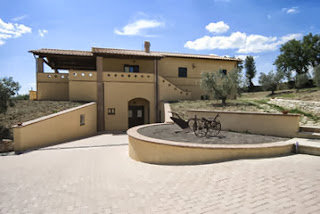by Dwight Casimere
Perticaia Montefalco Rosso is an intense, but versatile wine that hails from one of Italy's newest "old" discoveries, the Umbria region, home of the indigenous Sagrantino grape, which is one of the key components of this rich, food-friendly wine. A blend of three distinctly Italian grapes, 70% Sangiovese,15% Sagrantino and 14% Colorino, Perticaia Montefalco Rosso is a full-bodied wine that is a tremendous value at around $14. The wine goes with just about anything you'd serve at the Fall table, from salami and cold cuts to pasta and first course dishes to traditional Umbrian cuisine or Mediterranean cuisine. The wine is fresh, with the taste of wild ripe red berries with flavors of wild strawberries, raspberries and lingering notes of blueberries mixed in. The mild tannins make it a great wine to pair with food. It can be enjoyed right away or laid down in the cellar for up to five years. Hearty fall dishes such as braised squash risotto, Osso Buco (braised lamb shanks), lasagna, eggplant Parmesan or old fashioned oxtail stew are perfect with Perticaia Montefalco Rosso.
A note about the Sagrantino grape: It's the newest noble wine variety of Italy, dating back to 1549 in Montefalco. The Sagrantino name can be traced back as far as 1088, when monks began cultivating the grape to create a sweet, raisin wine used for religious rites. The grape almost disappeared from Umbrian vineyards in the 1960s, but diligent work by a few pioneering producers in conjunction with scientists at the local university, reintroduced the grape and the producers obtained the D.O.C. label in 1979. The Sagrantino grape is now used to produce outstanding wines, either as 100% Sagrantino or as a blending grape with a host of local and international varietals. In 1998, the few Sagrantino vines that still flourished within the city walls of Montefalco were labeled and classified. Some were found to date back to 1700 and 1800. The sacred nature and lineage of the wine is affirmed by their presence in the ancient monasteries of St. Claire and St. Leonard.



No comments:
Post a Comment